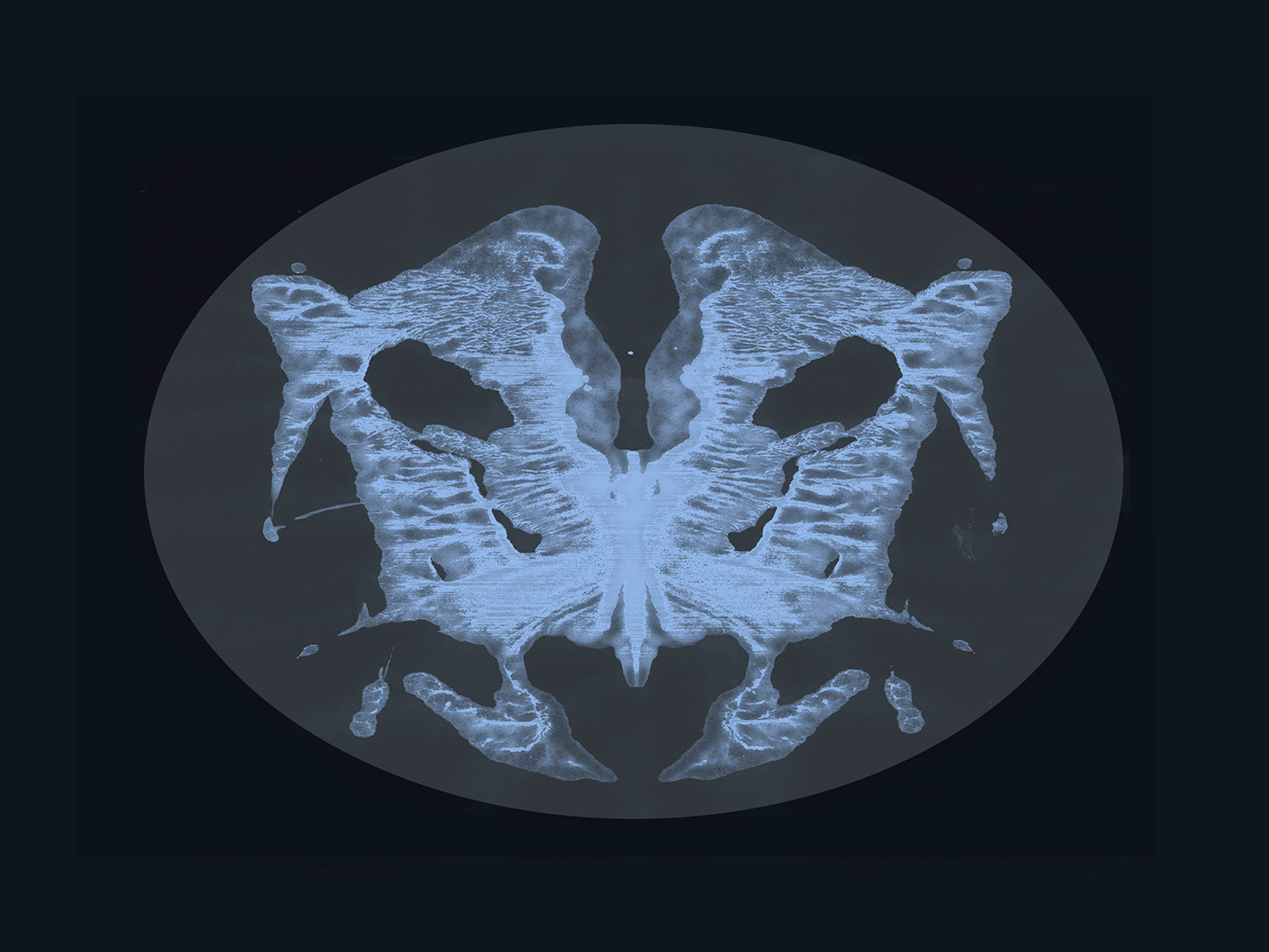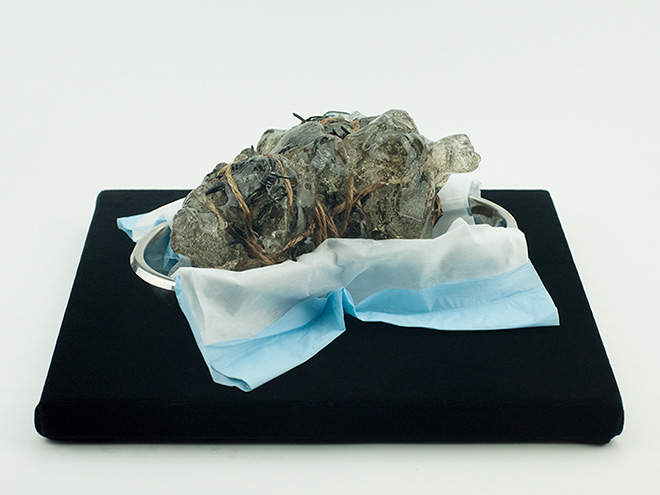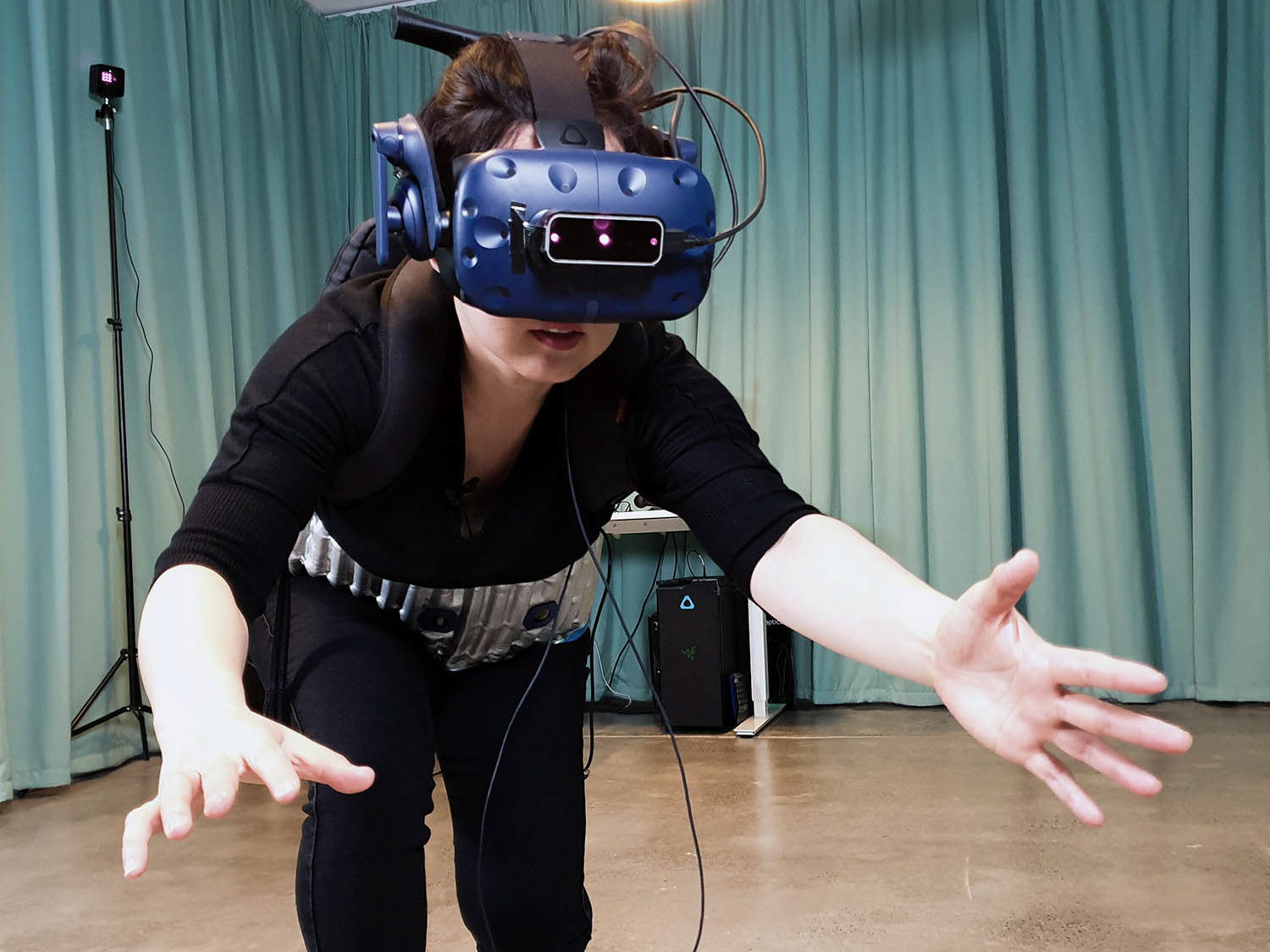Seeing Is Believing 2016
Details: custom-built anechoic chamber, VR goggles, Arduino controlled gloves, mid & subwoofer speakers
Installation view: UNSW Galleries, University of NSW Art & Design
Seeing is Believing is an experimental art project that incorporates pain science, technology and pain community consultation to explore the neuropathic pain type called Complex Regional Pain Syndrome (CRPS). This artwork is a multi-sensory, participatory performance installation that involves one-on-one interactions between me and a participant. The interaction lasts approximately 30 minutes to an hour, using Virtual Reality, Mediated Reality and conversation.
There is a deep stigma surrounding persistent pain and those who live with it. Pain experience is unshareable and invisible, making it hard to be believed. Not believing someone can be both cruel and imperceptive, yet it happens all too often. So, what do we do when there's no concrete proof to show the world its complexities, and no one believes us?
The conception and development of Seeing is Believing was a collaborative effort with clinical neuroscientists from Body In Mind (BIM) based at Sansom Institute for Health Research at the University of South Australia, and Neuroscience Research Australia, as a direct result of the artist’s research residencies through Synapse (Australian Network for Art and Technology, ANAT) and Amplify Your Arts (Accessible Arts) grants.
Seeing Is Believing Installation view 2018
Installation view: Museum Of Discovery (MOD.) South Australia
This experimental project was based on the latest studies of pain science and the community of lived experience, ethically collected during the 2-year creative development residencies.
The artwork challenges our expectations and (mis)understanding of what pain is. The main goal of Seeing is Believing was to transform the science and lived stories into an art experience, offering a perspective that helps us understand the role of our brain in persistent (chronic) pain. The artist's intimate performance, in addition, sparked an alternative vision for what a social interaction, layered with care and understanding without judgment, could look like.
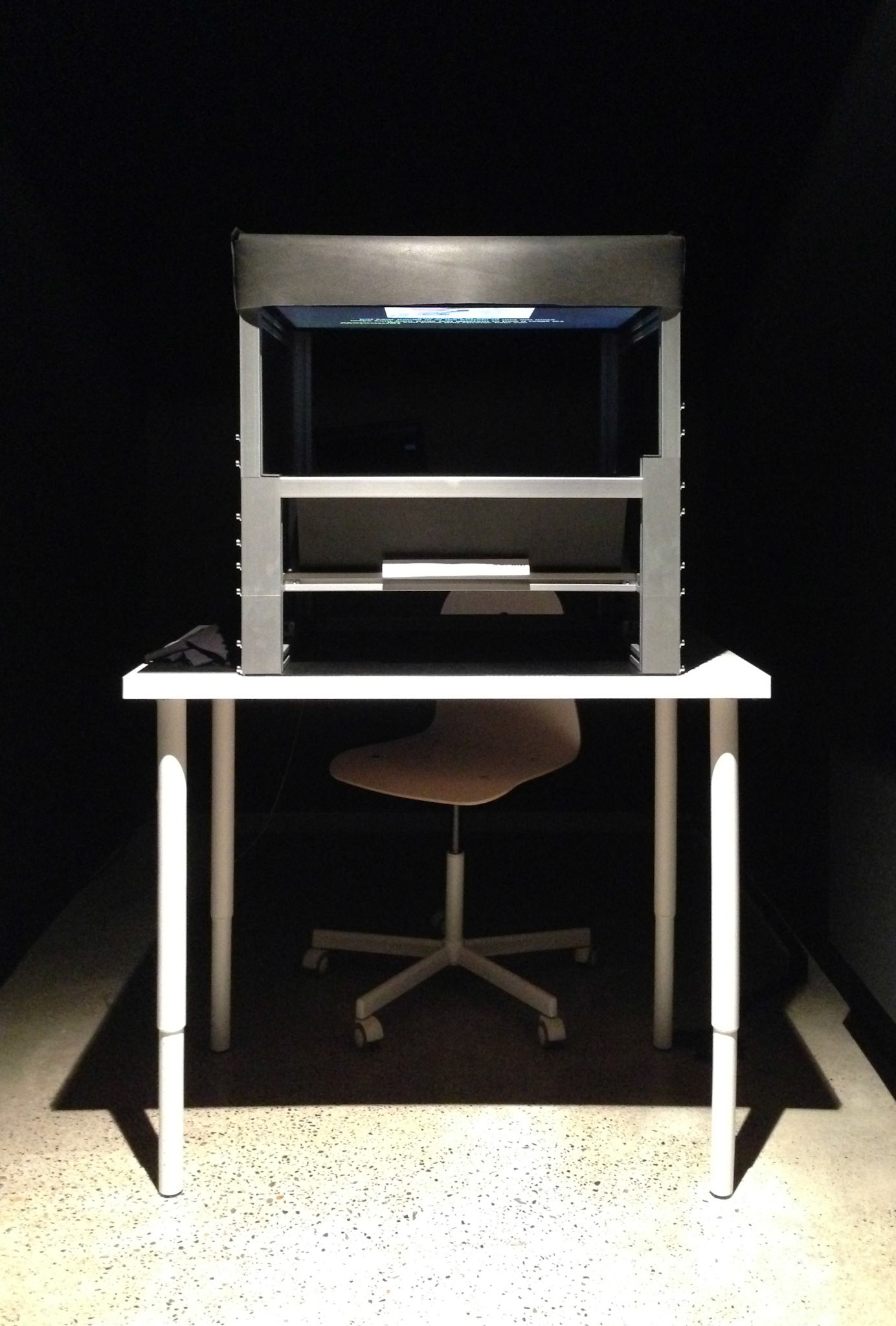
Mediated Reality - The Mirage Machine
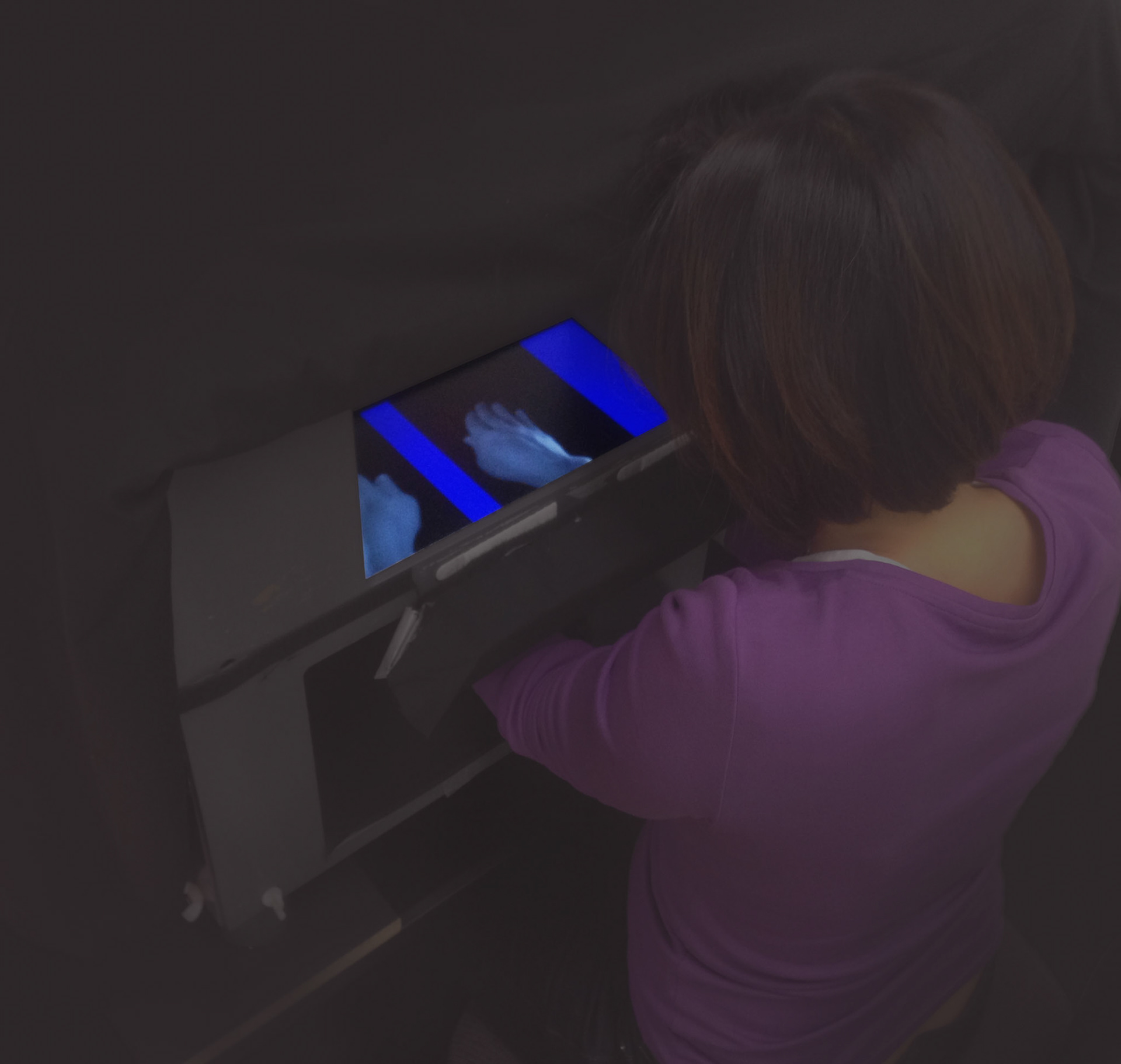
The Mirage Machine manipulating the visual-proprioception (vision & movement/position) of their hands
The first stage
A participant is led to a Mediated Reality machine called the MIRAGE – an illusory machine whose screen distorts the participant’s view of their hands in a manner that is incongruent with what their actual hands are doing.
Scientists at BIM use the MIRAGE to study how the brain makes sense of the body, and how persistent pain and dysfunctional cognitive functions are inherently related. Within the artwork, these same processes are adapted into the artist’s performance to prime participants with the knowledge that their perceptions, which they usually believe to be definitive, may indeed be false. The artist modifies her performance with each participant to shift their focus towards the context of pain.
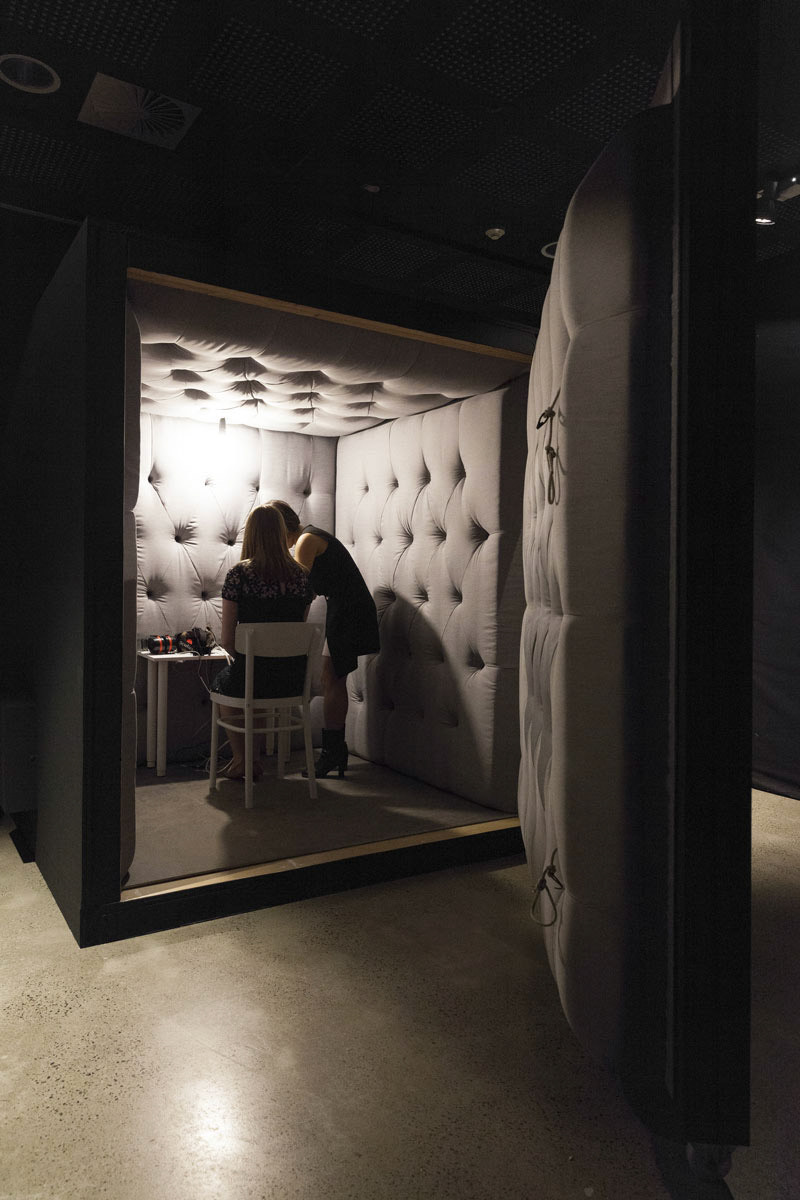
UNSW Galleries 2016. credit: Silversalt photography
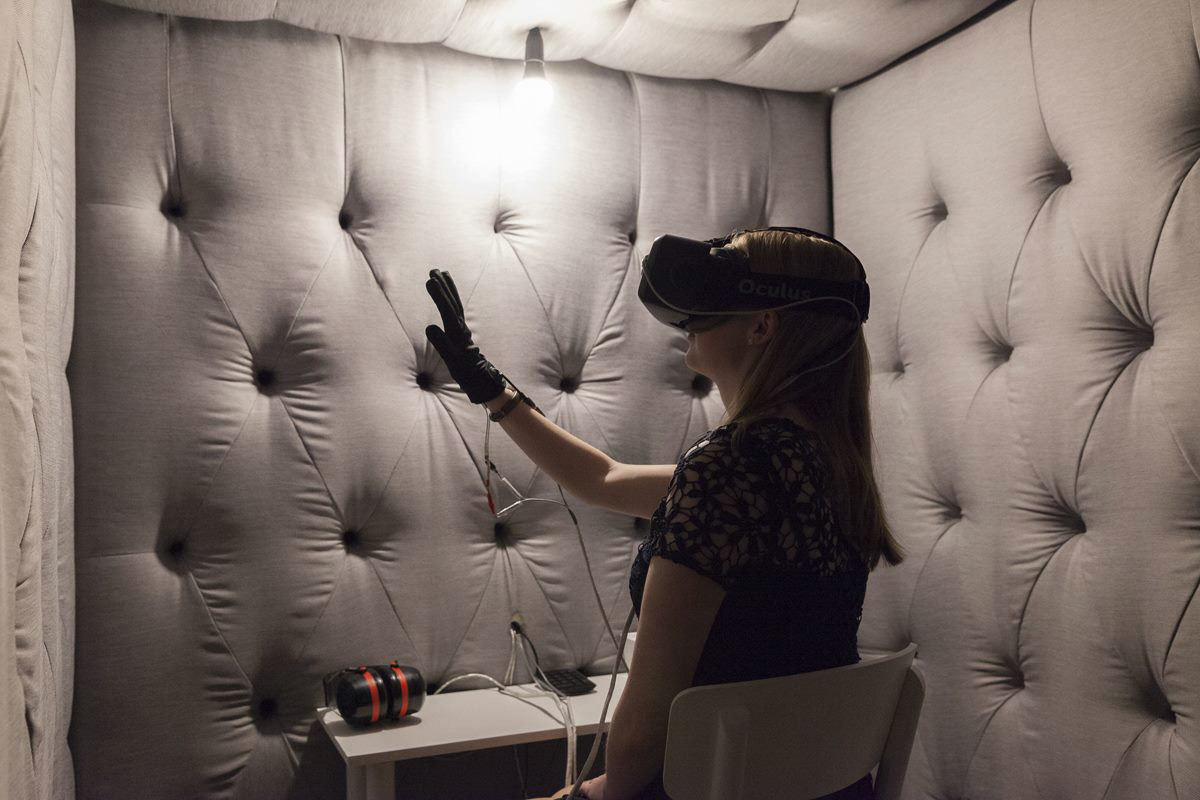
Inside view of custom-built anechoic chamber. Model Dr Hayley Thair. credit: Silversalt photography.
The second stage
The participant is invited inside a purpose-built anechoic chamber that was designed to look like a domestic setting with tufted walls. Once the door is shut, the acoustics within the chamber provides the participant with an immediate change in atmosphere. Although it is invisible, the senses within the chamber are simply not the same as in the outside world – this metaphorically resonates with the altered sensory-cognitive responses of people living with chronic pain.
The small, enclosed room also symbolises psychological and social isolation. No one can witness nor share what the participant is about to experience without going through it themselves.
The artist helps the participant put on a purpose-built glove and a pair of Virtual Reality (VR) goggles, all the while ensuring the context is focused on pain. The participant then begins to experience artistically interpreted CRPS symptoms and visual effects felt and seen through the glove and VR. The surrounding virtual barbed wires represent the metaphorical embodiment of the artist's own pain perception and a recurring theme in her works.
The sensory effects are compounded by the subwoofer speakers hidden behind the walls. These produce a sequence of low-frequency vibrations that create an unsettling and nauseating effect on some participants.
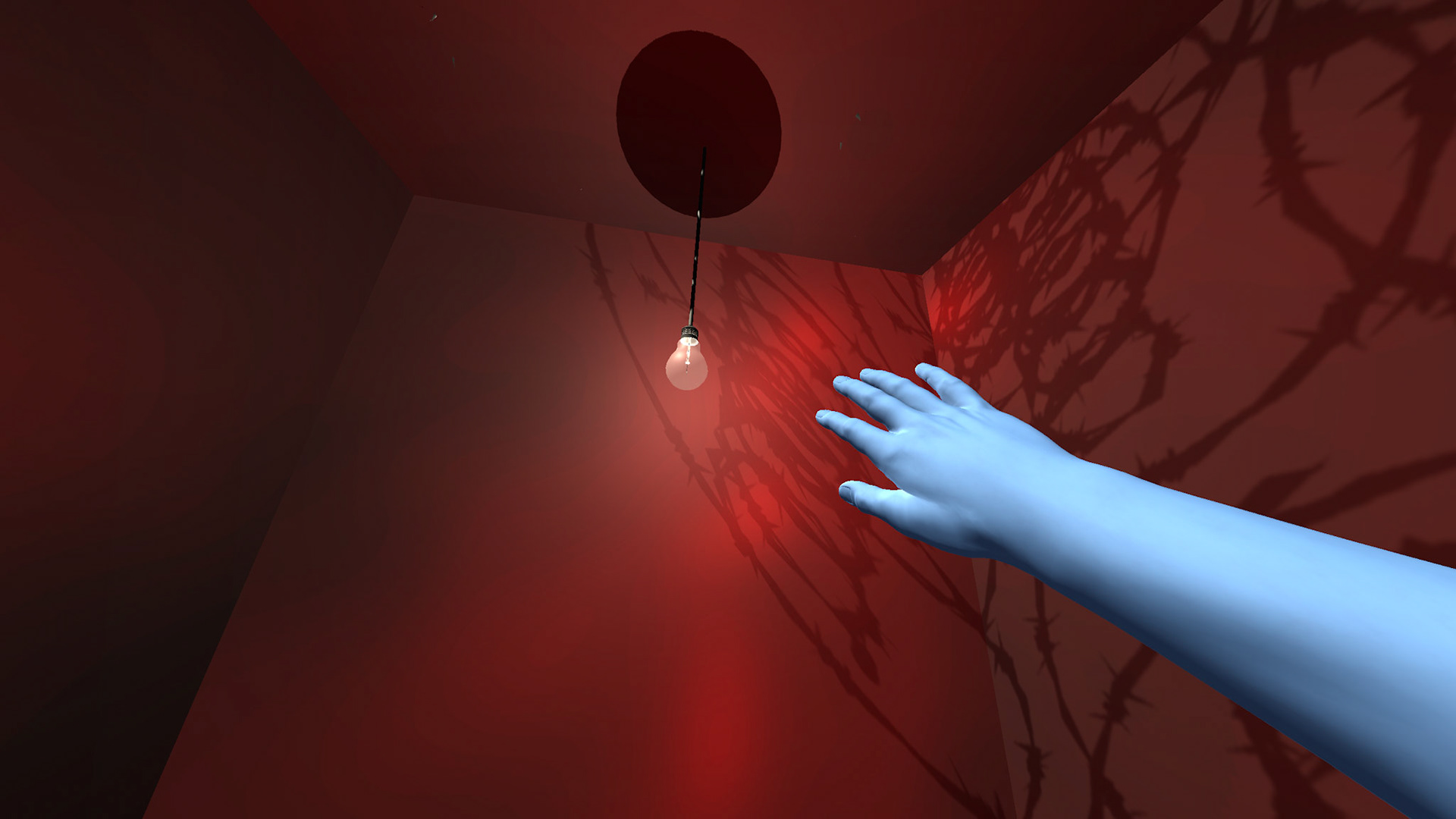
VR scene of a participant's hand (Image credit: Dr Andrew Burrell)
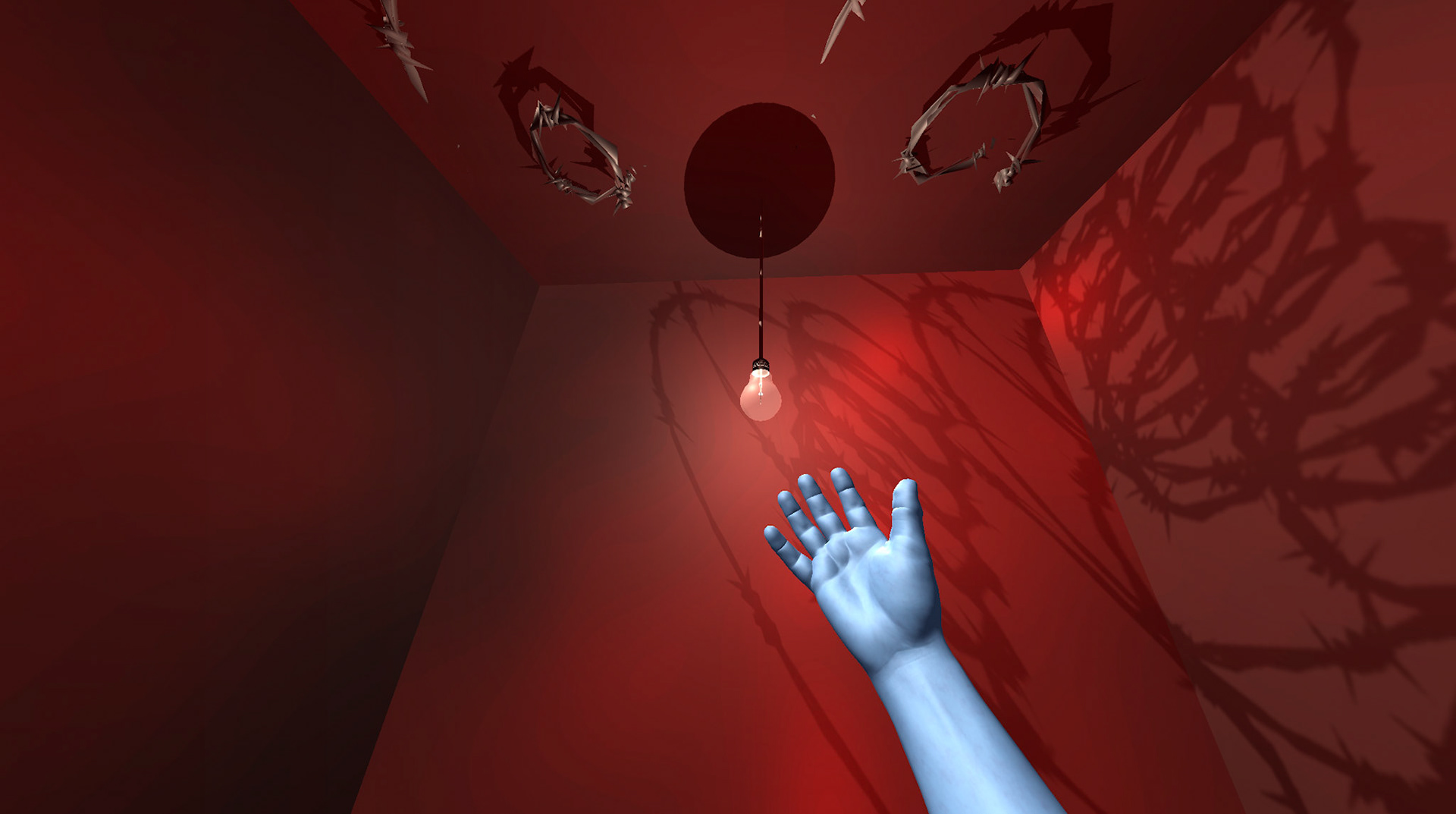
VR scene of a participant's hand, CRPS stimulation 1 (Image credit: Dr Andrew Burrell)
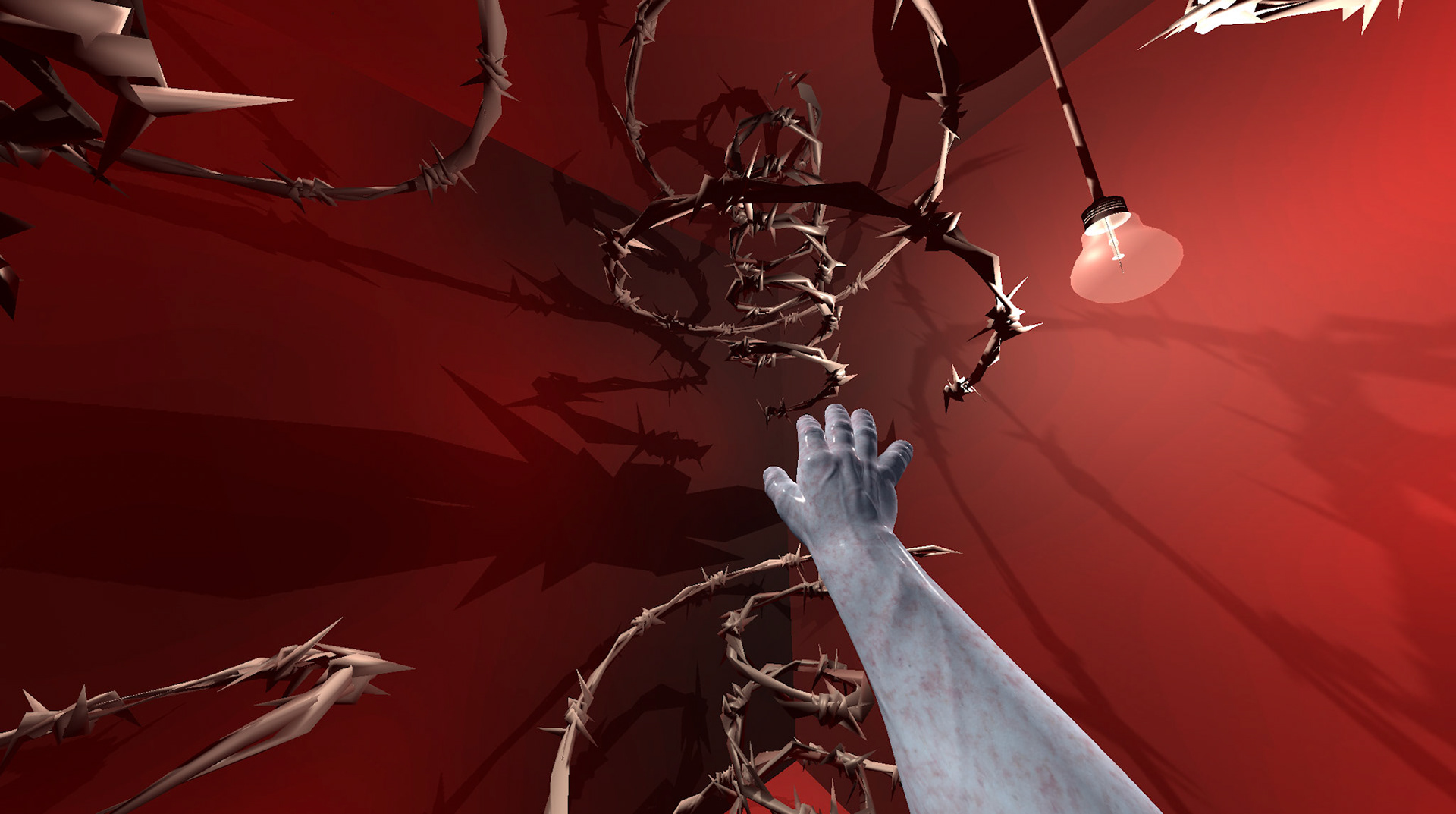
VR scene of a participant's hand, CRPS stimulation 2 (Image credit: Dr Andrew Burrell)
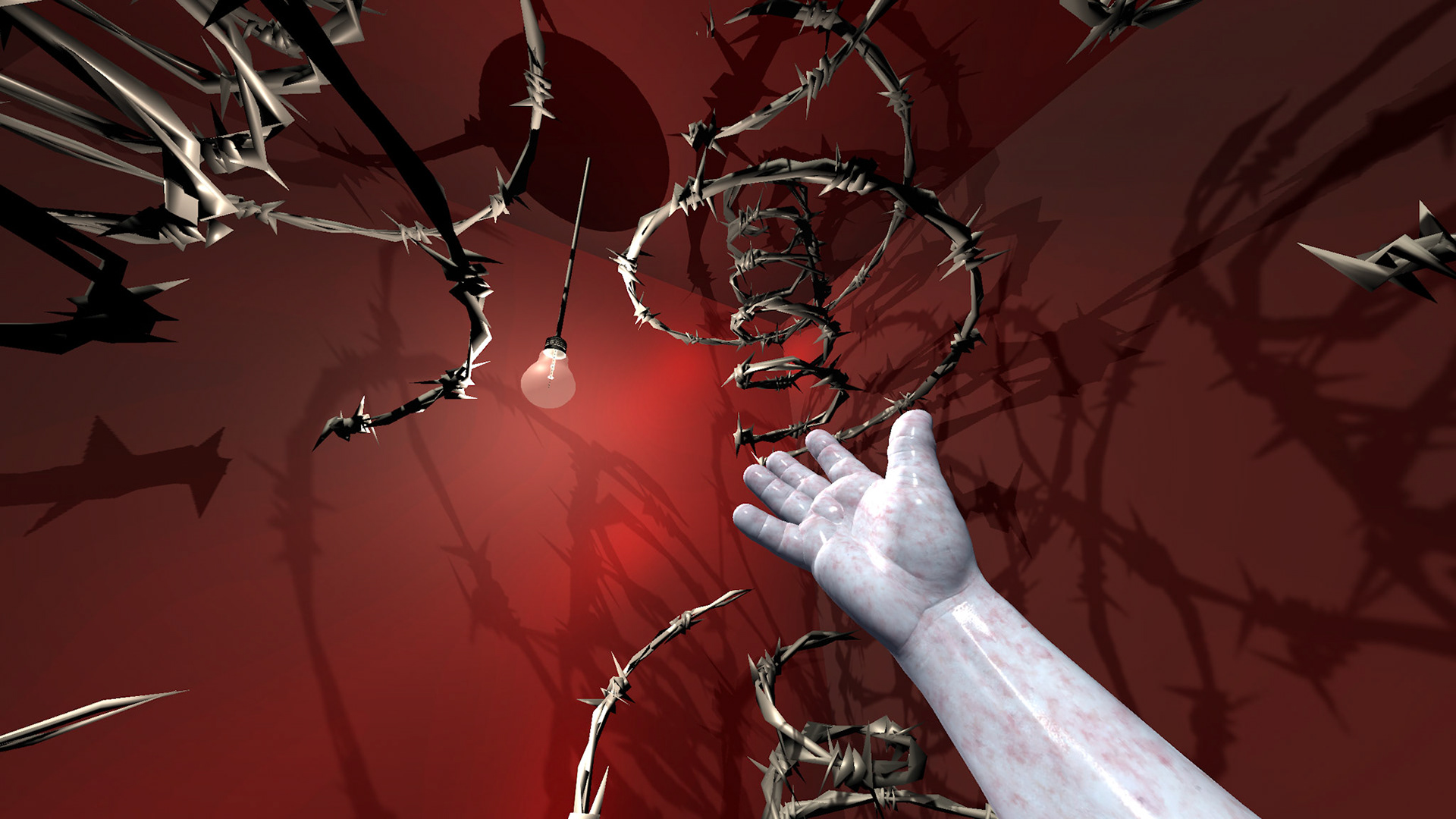
VR scene of a participant's hand, CRPS stimulation 3 (Image credit: Dr Andrew Burrell)
The last stage
The artist evaluates and validates the participant’s responses, whilst sharing the concept behind the artwork and the related scientific pain research. If needed, the artist guides them through a simple grounding exercise to finish.
The creative rationale
Many of the artist’s earlier works had their origins in the psycho-social sphere of her personal experience. More recently, as a direct result of her research residencies with scientists and clinicians, Eugenie has started to explore the broader nature of persistent pain and Seeing Is Believing is an attempt to share some of this knowledge.
CRPS is a condition that the general public is not familiar with. This neuropathic pain condition is not rare, yet it is often unacknowledged and is most certainly under-researched. It is also notoriously difficult to diagnose and treat, as there are no direct clinical tests that can provide physical evidence for its existence. Seeing Is Believing is based on the latest studies by the pain researchers and patients’ narratives collected during the residencies.
The work was designed in such a way that each participant experiences not only a glimpse into the challenges of CRPS, but also its emotional and social strains, including anxiety, anticipation and vulnerability. Every participant’s reaction to the artwork is different, and not every participant’s perceptions can be “tricked” through the illusions and social interaction into having pain-like responses. However, nearly every participant’s experience leaves them with an altered perspective on what persistent pain is about and on the responsibility as members of society - that what we do, say, and behave towards others, including people living with pain, has a ripple effect.
Credits
Pain Science collaborators: Dr Tasha Stanton, Dr Valeria Bellan and Professor Lorimer Moseley, University of South Australia
Mirage machine developer: Associate Professor Roger Newport, Dr Hayley Thair, University of Nottingham
New media artist: Dr Andrew Burrell
Wearable device developers: Stuart Esdaile, Rosie Menzies, Tom Hazell, Blake Segula, Corey Stewart
Acoustic Engineer: Meisha Stevens
Architect: Matthew Bolton, Cassandra Prasad
Seeing Is Believing was originally commissioned for The Patient: The Medical Subject in Contemporary Art, curated by
Dr Bec Dean, supported by the Australian Government through The Australia Council for the Arts and the NSW Government through Create NSW.
This project was also supported and funded by the Australian Network for Art and Technology (ANAT) through Synapse Residency in association with the Australian Government through the Australia Council for the Arts, its arts funding and advisory body; supported by Amplify Your Art Residency by Arts NSW and Ageing, Disability and Home Care’s Amplify your art program, a devolved funding program administered by Accessible Arts on behalf of the NSW Government; AARTS Quick Response Grant Program was by devolved funding administered by Accessible Arts (AARTS) on behalf of the Lifetime Care and Support Authority (LTCSA); and Body In Mind research group (BIM) based at the Sansom Institute for Health Research at the University of South Australia.
Special thanks to Prof Lorimer Moseley and his team at Body In Mind (BIM) at the University of South Australia; A/Prof James McAuley and his team at Centre for Pain IMPACT at Neuroscience Research Australia (NeuRA); Vicki Sowry (ANAT); A/Prof William Martens and Prof Philip Poronnik at the University of Sydney; Dr Dylan DeLosAngeles and Museum Of Discovery team (MOD.) Mike Buick, Michael Grave, Rob Yuan, Steven Cybulka and Sean Powell; Rachel Piercy, Jane Hosking and the staff at the Manning Regional Art Gallery; Dr Melentie Pandilovski and Serena Wong at The Riddoch Art Gallery.
Special thanks also to Dr Duncan Sanders and Prof Michael Nicholas at Pain Management Research Institute (PMRI) at the University of Sydney for allowing the artist to attend ‘Placebo Symposium 2017: Harnessing Placebo mechanisms to improve clinical outcomes’. Attendance at this conference had a huge influence on the interaction with participants and its embedded narrative within the artwork.
Published Reviews
Eva Tordera Nuno, Bearing Chronic Pain: What Can Art Offer?, No NIIN, Issue 21, December 2023
Desiree Foerster, New Phenomenologies of pain and the re-conceptualization of health in the digital arts, The senses and Society, Routledge, 12 Nov 2023, DOI: 10.1080/17458927.2023.2274753
Namila Benson and co-host Carly Findlay, What Does Access Look Like In The Arts?, ABC The Art Show, 02 December 2020
Dylan DeLosAngeles, ‘Eugenie Lee’s Seeing is Believing: VR in pain management’, Artlink, Issue 38:4 December 2018, 73-77
#2 THE PAIN with Eugenie Lee and Dr Tasha Stanton on Chronic Pain, Virtual Reality, The Constellations: Podcast series, DLuxMediaArts, Moderated by Dr Bec Dean, 28 August 2018
Bec Dean, The art of Dis-ease Anxiety_Art and mental health, Artlink, Issue 37:3, September 2017
Keith Gallasch, Virtual Pain, Harsh Reality, RealTime 133, 2016
Eugenie Lee, Seeing Is Believing, ‘The Pain Revolution: Rethink, Re-engage, Recover’, Pain science blog, 12 March 2018
Enterprise, The Pain Illusion, University of South Australia 2015, p4-7
Hayley Thair, Seeing Is Believing: The Mirage Goes Down Under, Mirage Multisensory Illusion Lab, University of Nottingham, UK, 2016
Eugenie Lee, Synapse residency development blog, Australian Network for Art and Technology (ANAT) 2016
Eugenie Lee, Synapse residency development blogs, Australian Network for Art and Technology (ANAT) 2015
Public discussion, Eugenie Lee, Cat Jones, Dr Valeria Bellan: Artists and Scientist Discussion, The Art of Pain: Playing Tricks With The Mind - Illusion And Its Affect, University of South Australia, 28 July 2015
Natasha Mitchell, Art of Pain, Life Matters, ABC Radio National, 23 July, 2015
Feature Artist, Amplify Your Art Recipient Eugenie Lee, Accessible Arts, 19 November 2014
Siobhan Moylan, Pain as Muse, EastsideFM, 21 July 2014
Making of Seeing Is Believing
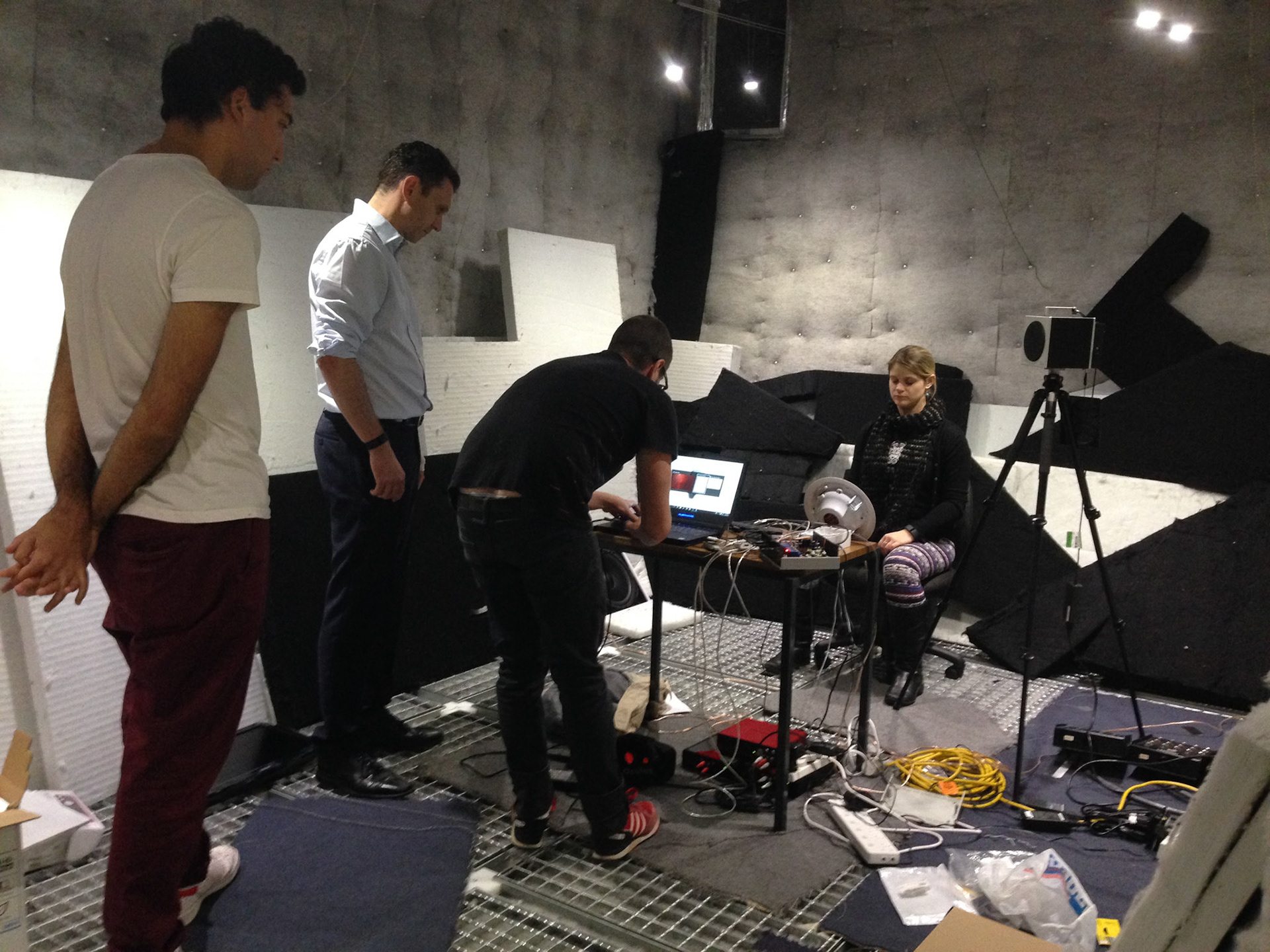
Testing before the installation. Andrew, Meisha, Blake and Mark
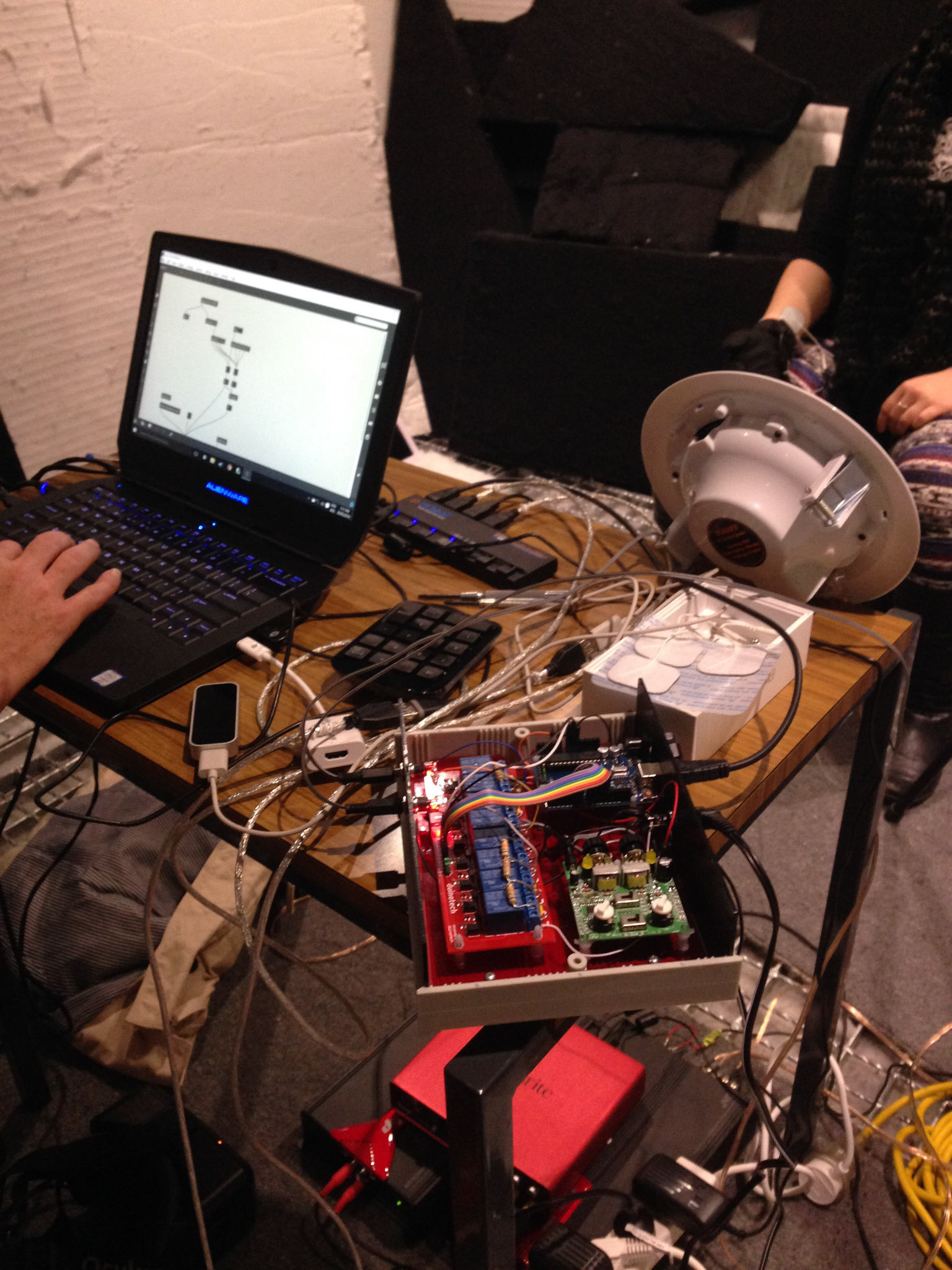
Testing acoustic & VR technology
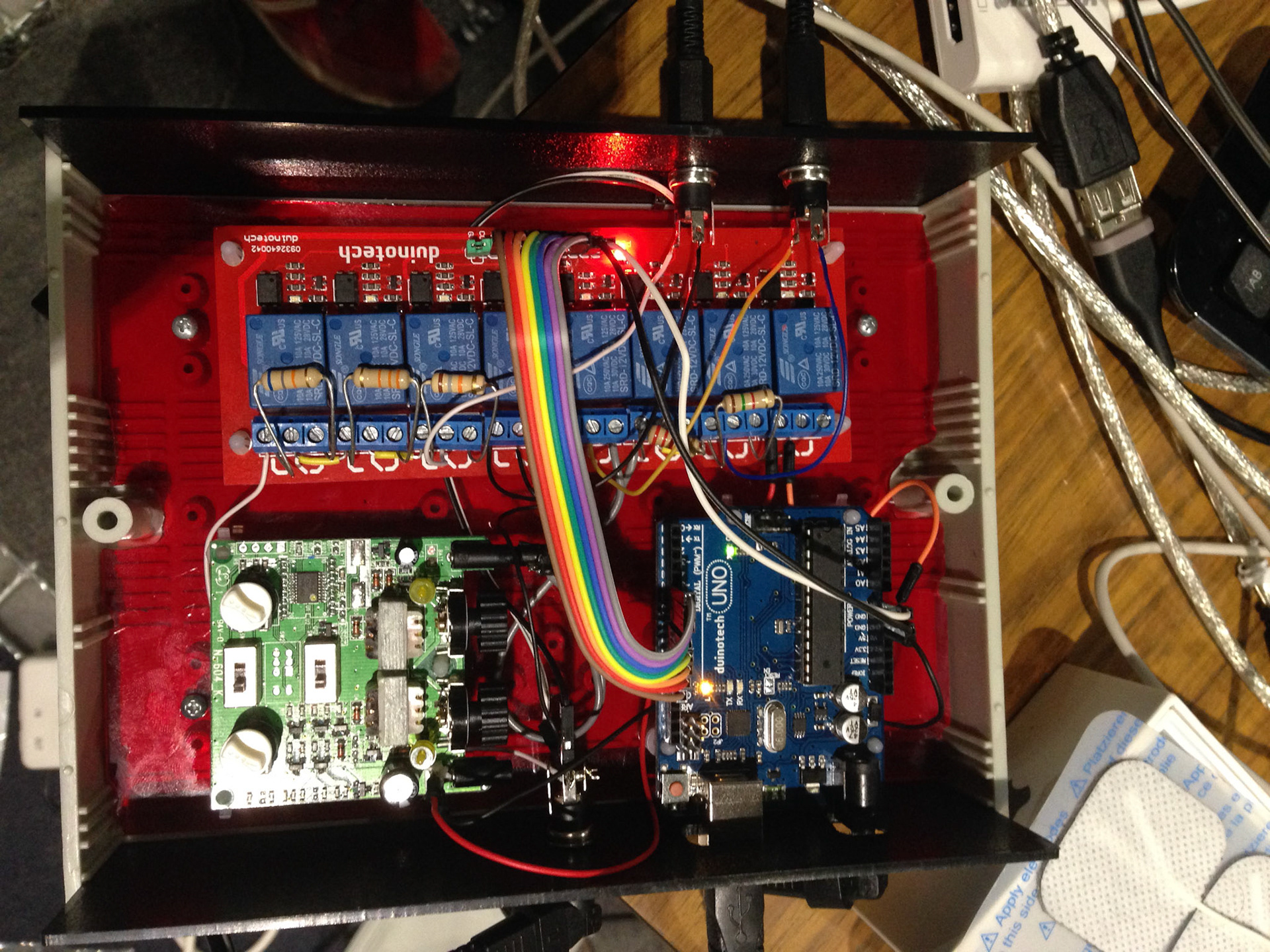
Inside the arduino for gloves
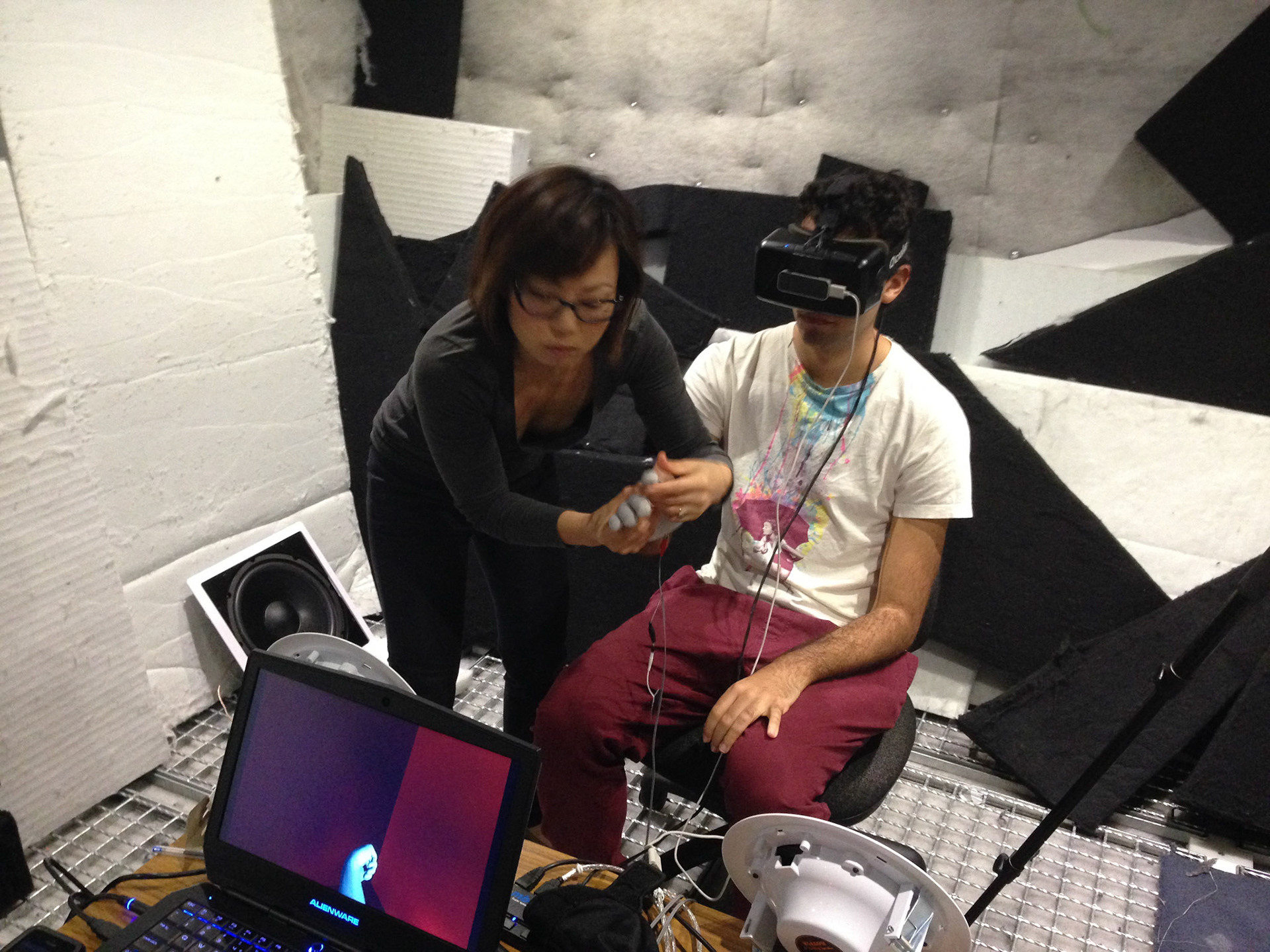
Final testing on Blake for the intensity of pain stimulation
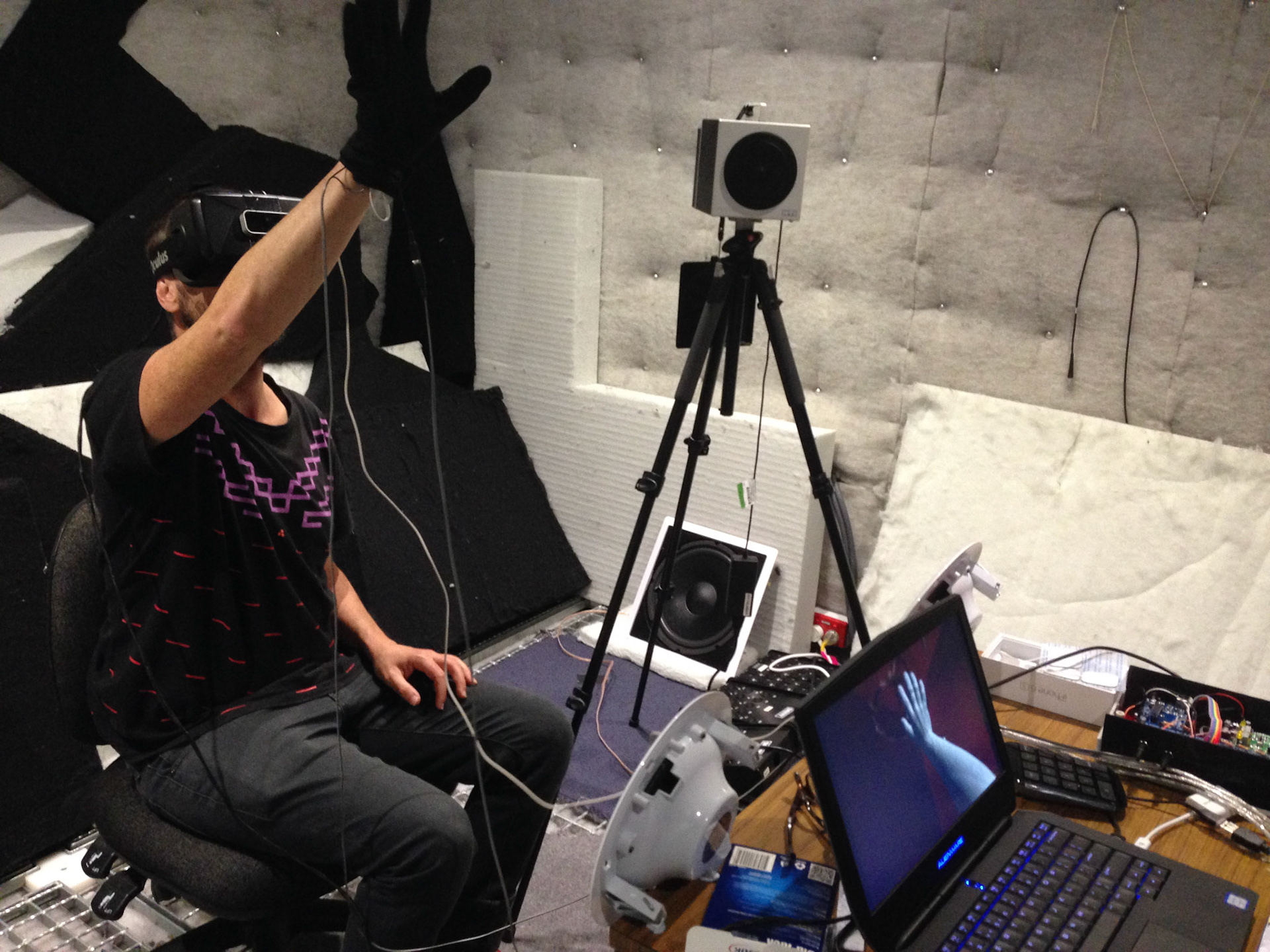
Andrew testing inside an anechoic chamber at Sydney uni
During my Synapse and Amplify Your Arts residencies at Body In Mind (BIM) based at Sansom Institute for Health Research at University of South Australia and Neuroscience Research Australia (NeuRA) 2014-15
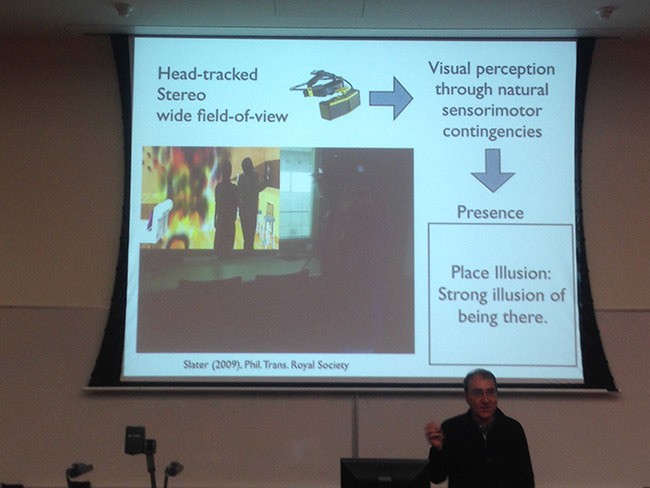
Prof Mel Slater giving a 1hr presentation with Dr Mavi Sanchez on the topic of empathy and VR. This talk single-handedly influenced my artistic process and pathways towards combining VR, empathy & pain into a new artistic concept.
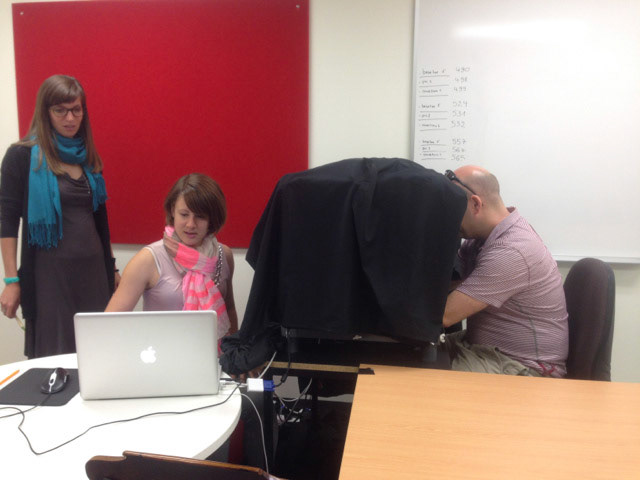
Dr Valeria Bellan and Eva Boesch manipulating Dr Neil O'Connell with the Mirage Machine
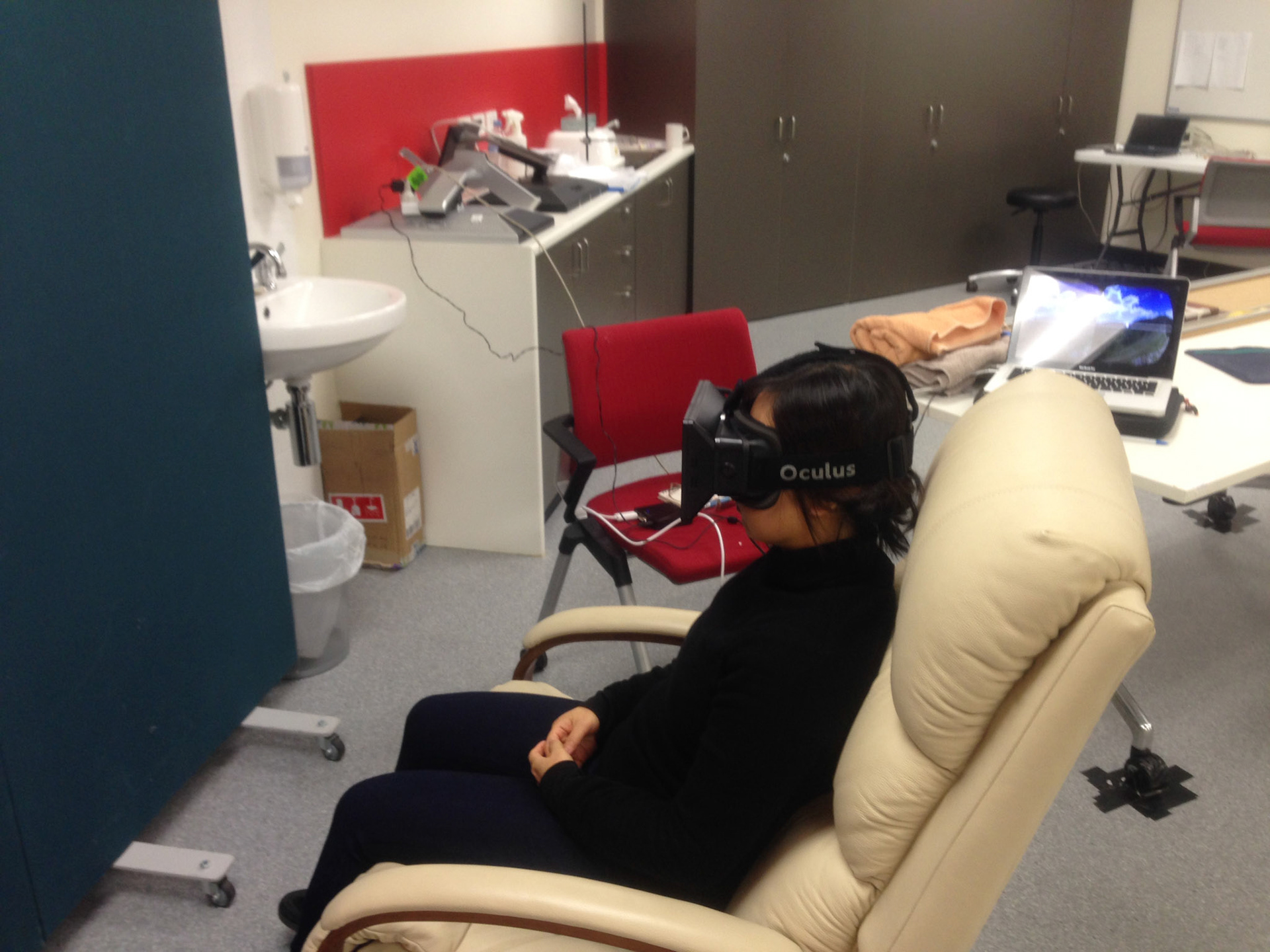
Trying out Dr Dan Harvie's VR experimental research for whiplash pain. This was my first time ever to put on a pair of VR goggles! A life changing moment for an artist.
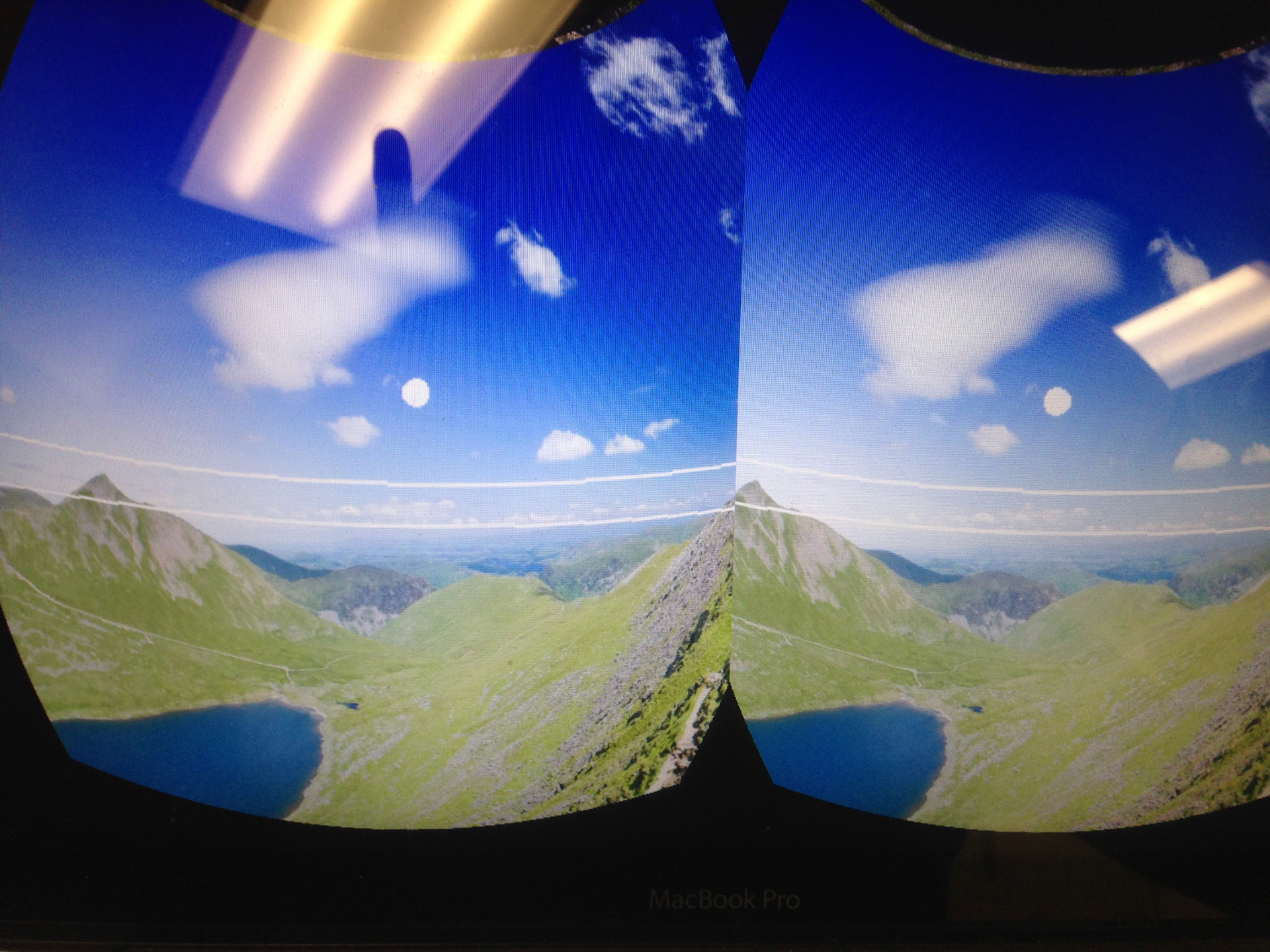
VR view of Dr Dan Harvie's whiplash pain experiment
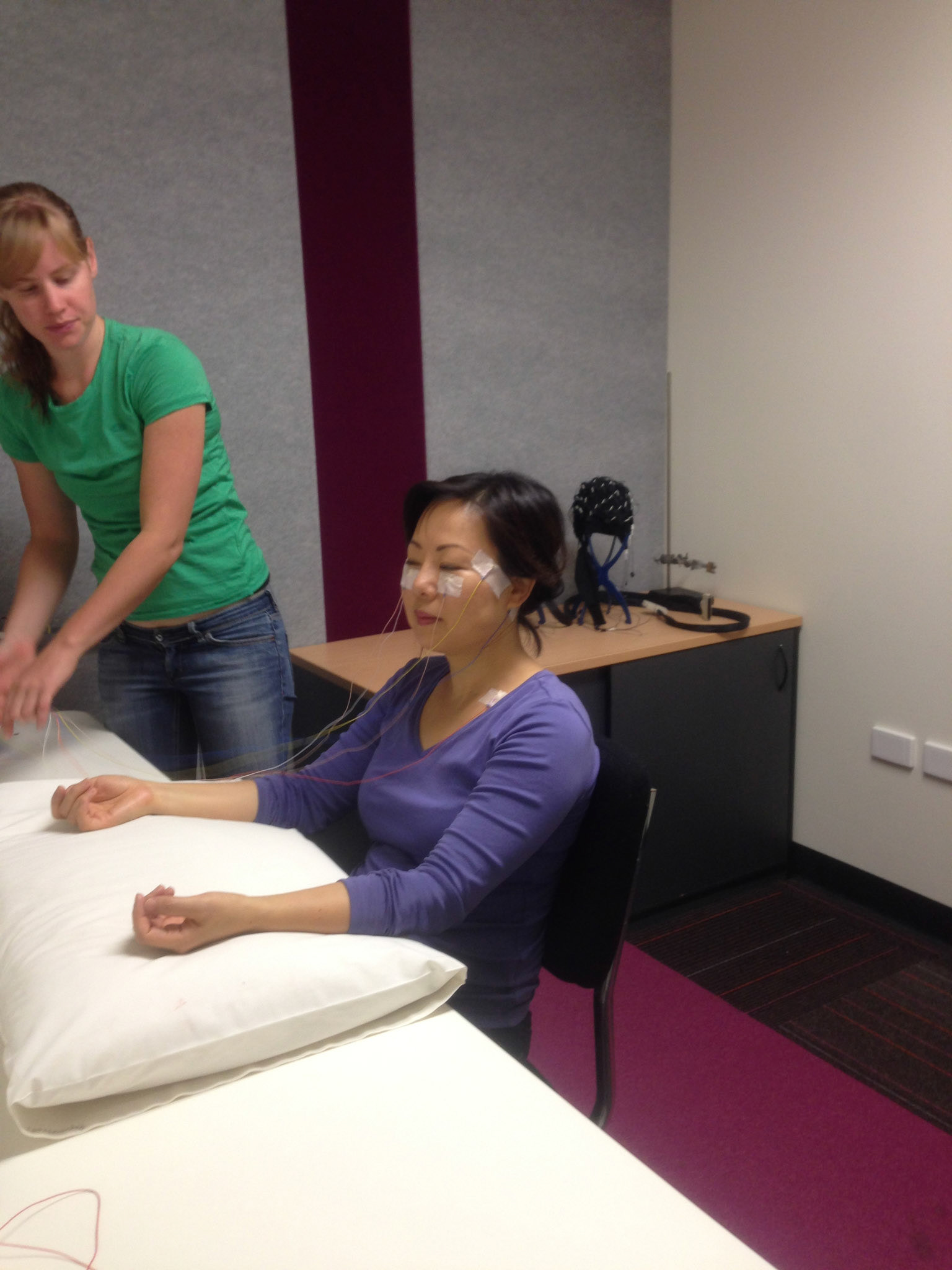
Dr Sarah Wallwork researching on defensive personal space (peri-personal space)
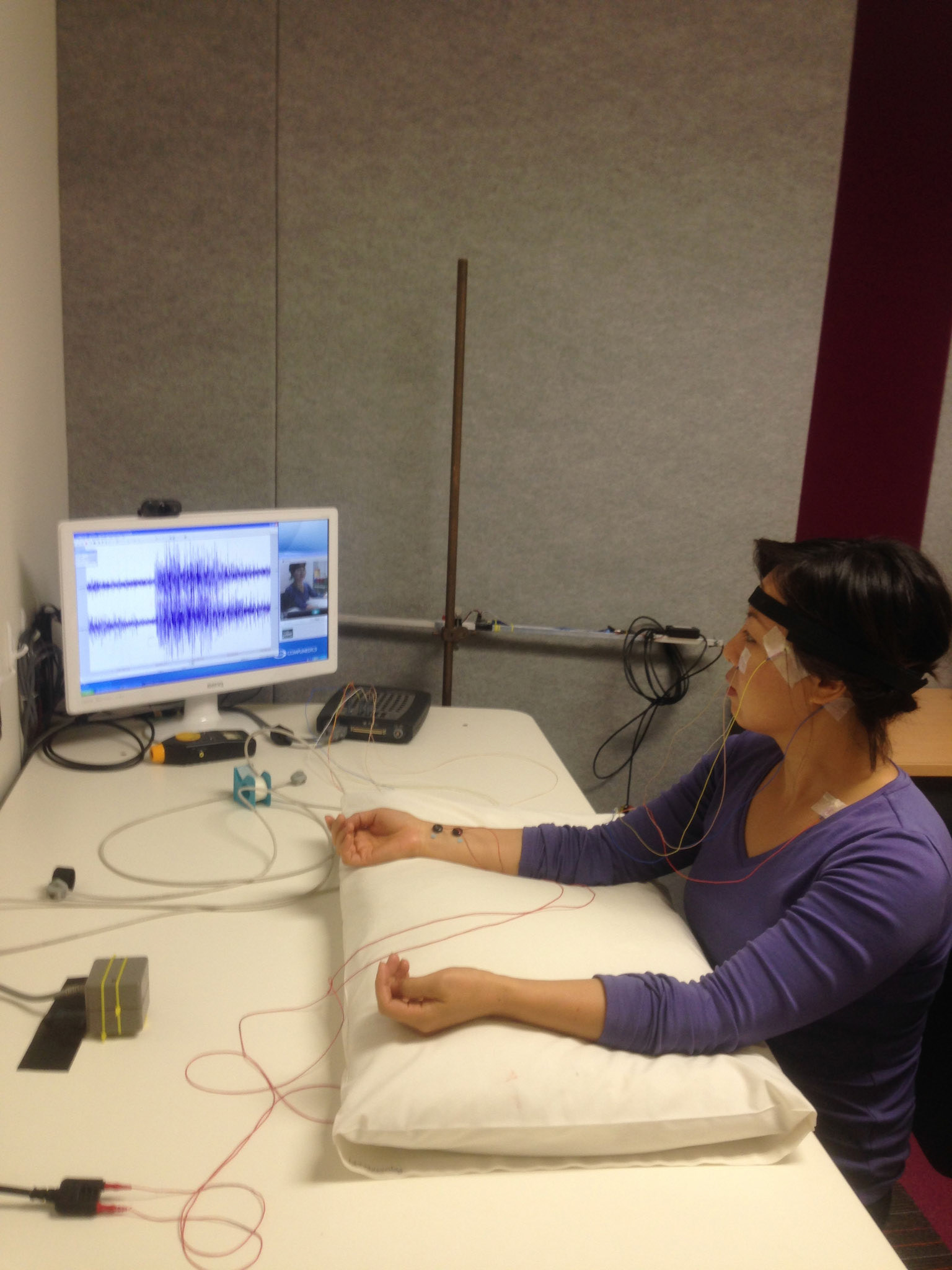
Participating in Dr Sarah Wallwork's research on peri-personal space
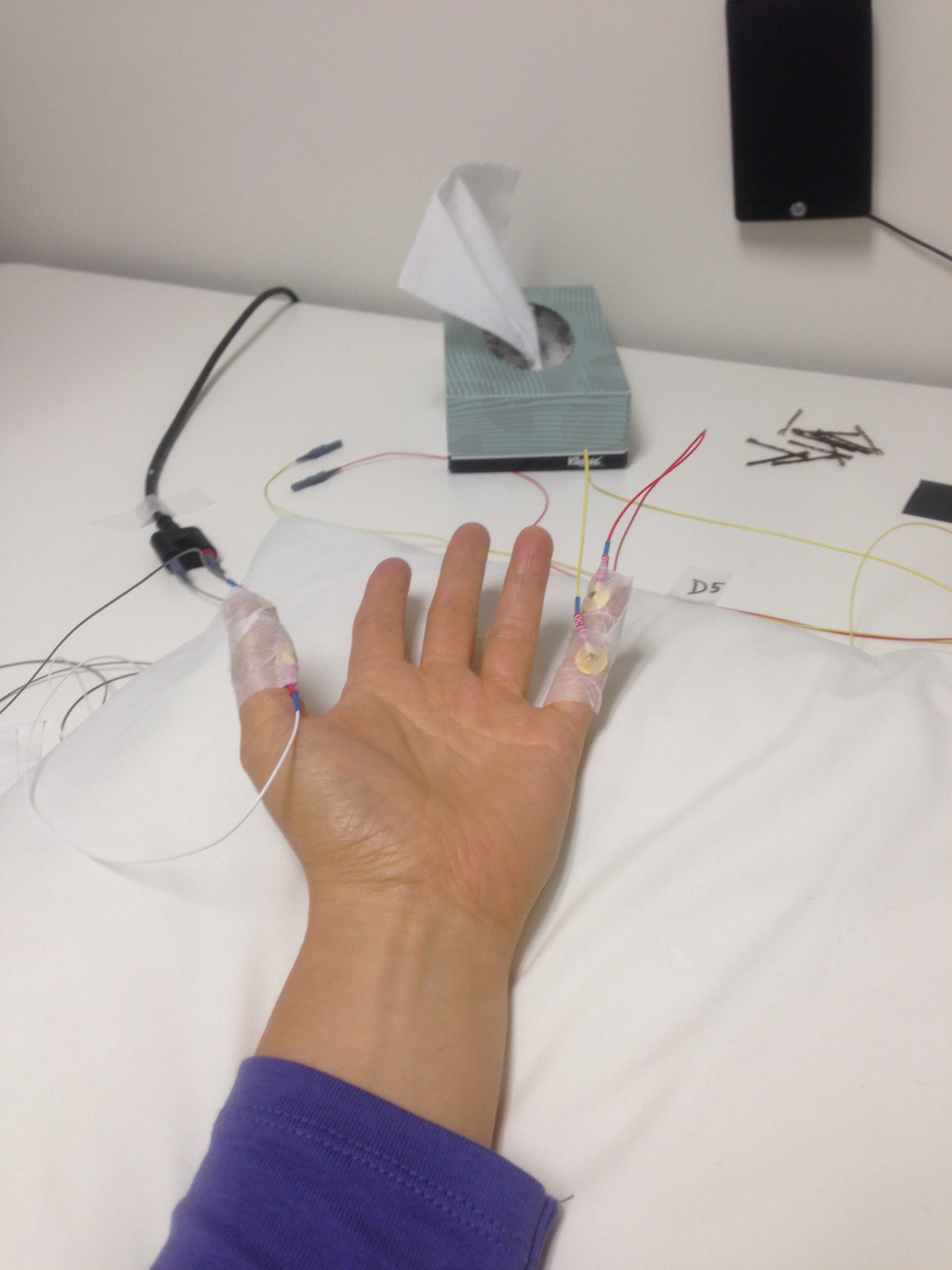
Getting ready for Dr Sarah Wallwork's peri-personal space test
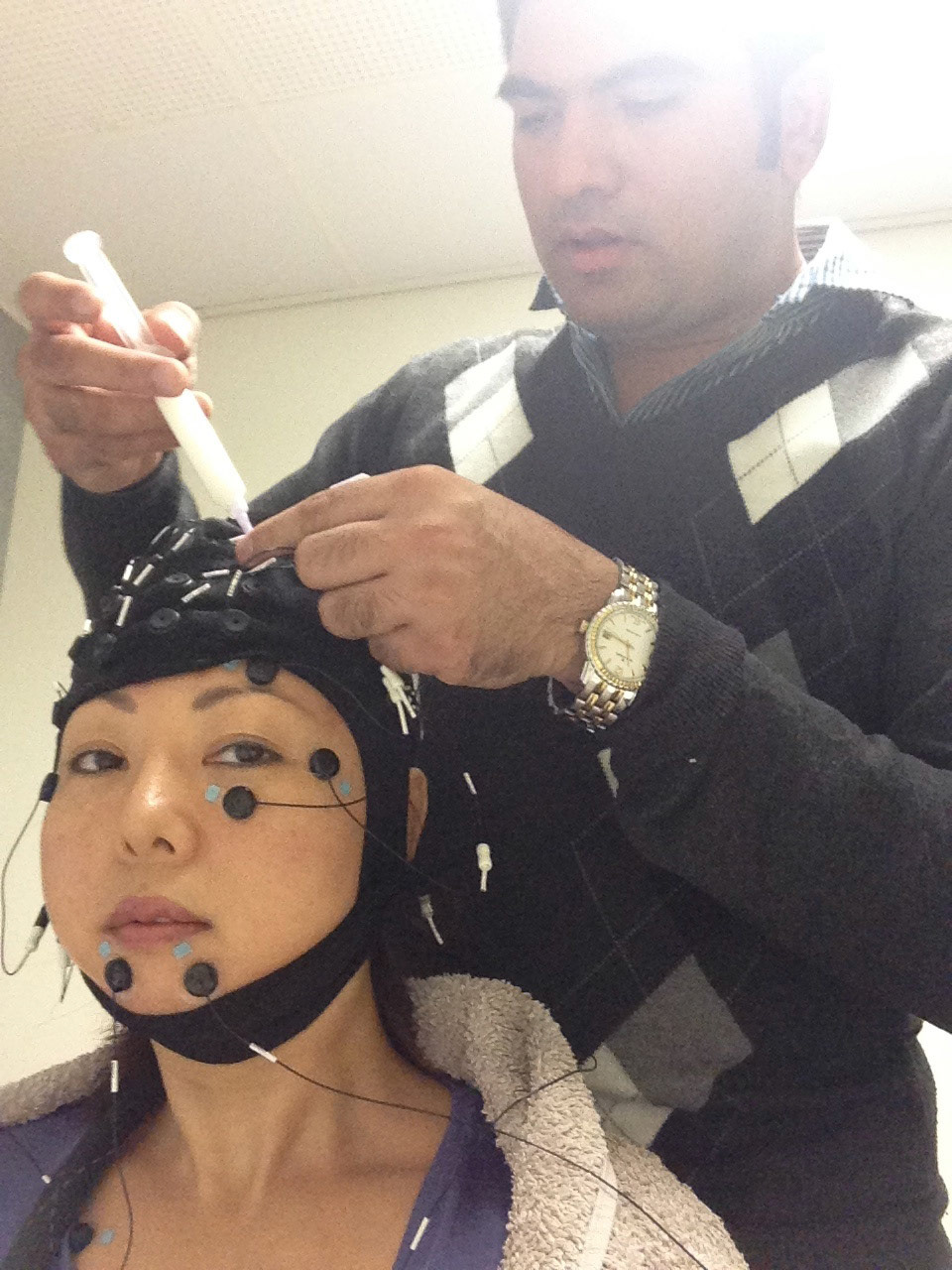
Muhammad putting on gel for an EEG cap
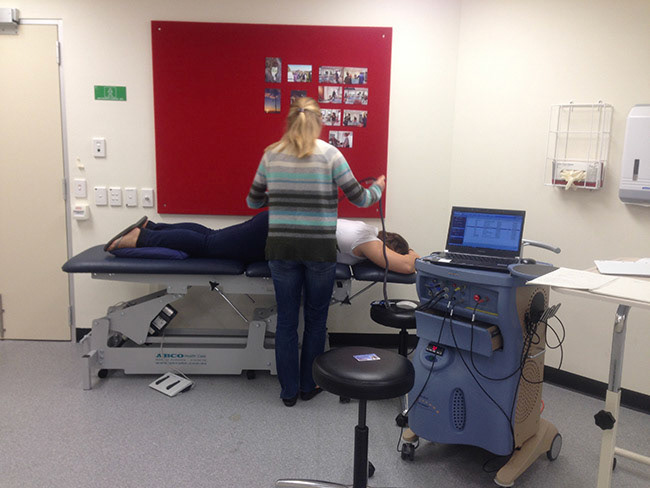
Dr Tory Madden experimenting on the concept of classical conditioning & pain
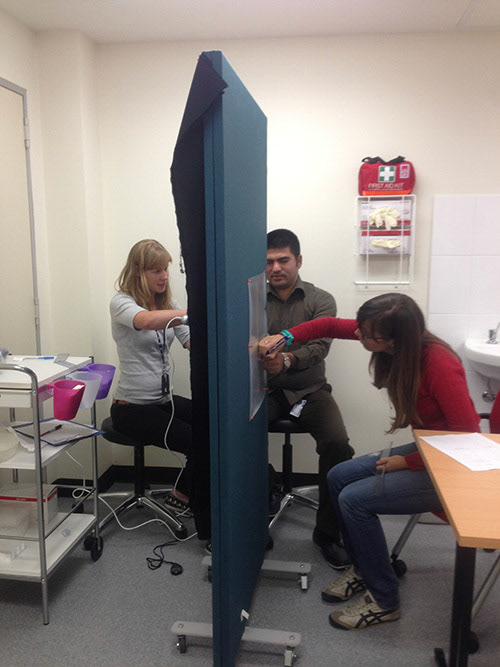
Dr Valeria Bellan & Dr Sarah Wallwork researching for proprioception on Mohammad's arm while his eyes were shut
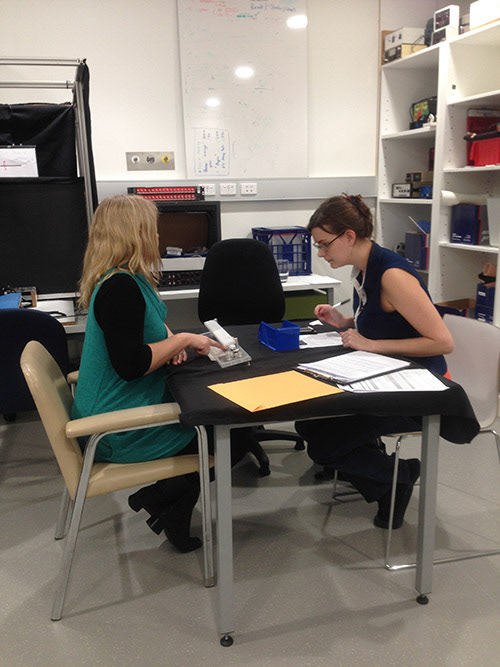
Cassie interviewing a patient participant for the CRPS research at Neuroscience Research Australia

